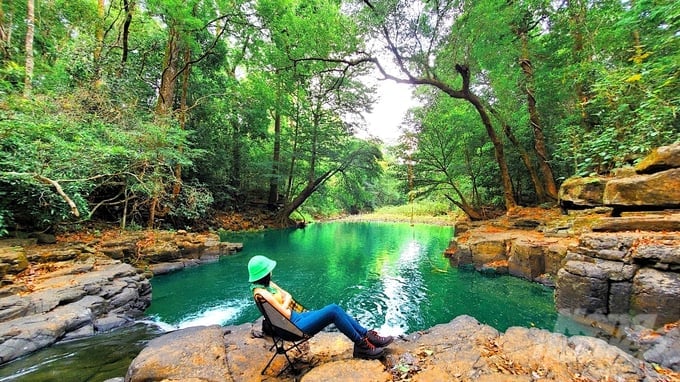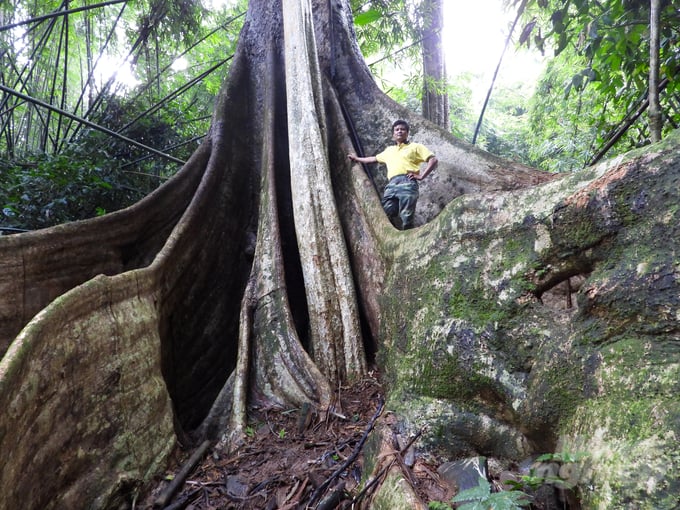November 25, 2025 | 06:46 GMT +7
November 25, 2025 | 06:46 GMT +7
Hotline: 0913.378.918
November 25, 2025 | 06:46 GMT +7
Hotline: 0913.378.918
Binh Phuoc province is currently managing a total forest area of over 171,000 hectares, including more than 31,000 hectares of special-use forests, 44,000 hectares of protection forests, and 97,000 hectares of production forests. These forest areas are also house to numerous scenic sites and landmarks. This natural advantage presents a significant potential for tourism development, including forest ecotourism.
Among the local landmarks, Bu Gia Map National Park, located in the communes of Dak O and Bu Gia Map, Bu Gia Map district, stands out with its extensive range of ecological landscapes, including Heaven Well, Dak Bo Waterfall, Dak Sam Waterfall, Dak Ka Stream, Bat Cave, Luu Ly Waterfall, and Dak Rot Waterfall. The historical fuel storage depot connecting the North and Southeastern regions is also located within the core area of Bu Gia Map National Park. Additionally, the park is home to 37 white crape myrtle trees, one Japanese Superb Fig tree, and one tung tree. These trees, ranging from 200 to 450 years old, have been recognized as heritage trees of Vietnam by the Vietnam Association for Conservation of Nature and Environment.

A scenic beauty reminiscent of a paradise can be found in Bu Gia Map National Park. Photo: HT.
Dr. Vuong Duc Hoa, General Director of the Bu Gia Map National Park Management Board, stated that the park, with a total area of nearly 26,000 hectares, is the largest contiguous primary forest in Binh Phuoc province. It is home to over 1,100 species of plants across various genera, families, and orders, serving as an invaluable genetic repository for the flora and fauna of the Southeastern region. The park preserves a deciduous ecosystem with low hills, an elevation under 1,000 meters above sea level, and rare wildlife such as bears, gaur, and elephants.
The area also boasts rich primary forest characteristics, dominated by dipterocarp trees and numerous valuable leguminous species such as Dalbergia oliveri, Pterocarpus macrocarpus, and Afzelia xylocarpa. In addition to its diverse natural landscapes and ecosystems, the park is home to the ethnic minority villages of S’tieng and M’nong in the buffer zones, with distinctive traditional cultural features. In acknowledgement of the park's potential, Binh Phuoc Provincial People's Committee designated Bu Gia Map National Park as a provincial-level ecotourism area on September 16, 2022.

Bu Gia Map National Park has remained as an attractive destination for tourists. The photo depics the Luu Ly Waterfall, which is located at the heart of Bu Gia Map forest. Photo: HT.
With its rich biodiversity, stunning natural landscapes and heritage trees, along with the distinctive traditional culture and cuisine of the S’tieng and M’nong ethnic groups, the park saw a steady increase in the number of visitors over the years. In 2023, this figure increased by more than 1,200 compared to that of 2022. Consequently, local residents found new employment opportunities, increasing their incomes and improving their lives by providing food and beverage services to visitors.
According to engineer Kieu Dinh Thap, Head of the Science and International Cooperation Department, Bu Gia Map National Park has made extensive investments and developed ecotourism tours in association with the forest. Consequently, the park attracted an increasing number of tourists seeking sightseeing, relaxation, and experiences, thereby creating employment opportunities and sustainable livelihoods for the local ethnic communities. "Notably, visitors arrive at the forest and develop a love for nature; similarly, the local residents is fully aware of the forest's value in contributing to income and economic improvement, leading to a greater awareness in forest conservation efforts," Kieu Dinh Thap noted.

Engineer Kieu Dinh Thap, Head of the Science and International Cooperation Department at Bu Gia Map National Park, standing beside an ancient crape myrtle tree, one of the 38 heritage trees found within the park. Photo: HT.
Regarding experiential tourism at Bu Gia Map National Park, Tran Kim Thuy, a tour guide from a travel company in Dong Nai province, shared, "With years of experience in the tourism industry, I find Bu Gia Map National Park to be one of the most impressive destinations. The pristine nature, fairy-tale-like landscapes, beautiful border routes, multiple rare plant species and heritage trees, and many other features, are all well protected.
The park is considerate in its preparations, the local people are friendly, and there are many forest specialties unique to local ethnic groups, such as thut soup, bamboo tube rice, can wine, roasted duck with mac mat leaves, stir-fried meat with nhip leaves, forest bamboo shoots, and wild vegetables. Additionally, visitors can enjoy a wide range of spiritual products such as traditional dances, songs, and festivals of the S’tieng and M’nong people, or experience trekking through the forest, wading streams, camping, and listening to bird songs."
"In acknowledgement of the potential for ecotourism development, Binh Phuoc Provincial People's Committee instructed Bu Gia Map National Park to implement various scientific projects with the aim of promptly reinforcing infrastructure, creating scenic sites, preserving the rich biodiversity of flora and fauna, and promoting the unique culture of the local community," emphasized Dr. Vuong Duc Hoa.
Translated by Nguyen Hai Long

(VAN) Green transition is crucial for the Mekong Delta amid climate change and stricter standards, offering a path toward sustainability.

(VAN) Dong Thap promotes agricultural restructuring, forms large specialized farming zones, raises the value of agricultural products and develops toward ecological and high-tech directions.
/2025/11/22/4018-4-213342_747.jpg)
(VAN) The Mekong Delta Agricultural Experts Club has attracted 143 experts and researchers to participate in providing consultancy and contributing initiatives to the development of one million hectares of high-quality rice.

(VAN) Ca Mau’s development of OCOP products opens a path to increasing cooperatives value, helping boost income, expand markets, and affirm collective economy's role.

(VAN) Turning seemingly ordinary coconut shells into unique jewelry and artwork, Nguyen Bang Nhi spreads the value of local culture through her brand, Cocohand.

(VAN) Results from the Sustainable Durian Model Project in Dak Lak have confirmed the critical role of Yara Viet Nam in transferring advanced nutritional solutions to farmers.

(VAN) In Tuyen Quang province, livestock farmers have introduced effective models and innovative practices that significantly strengthen African Swine Fever prevention and control efforts.